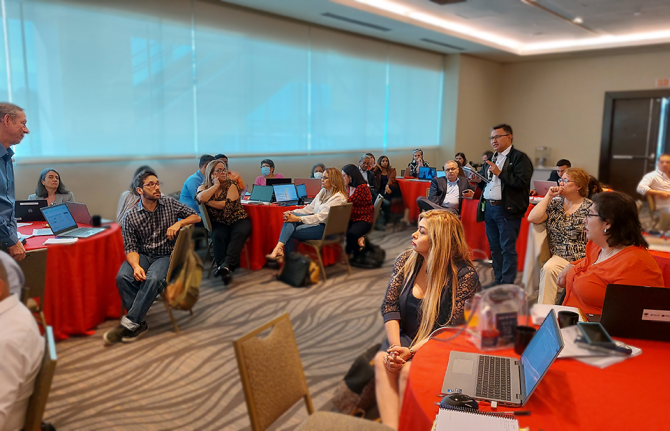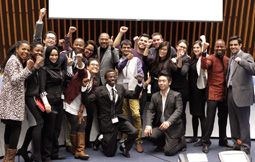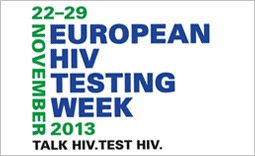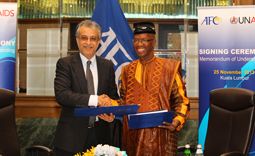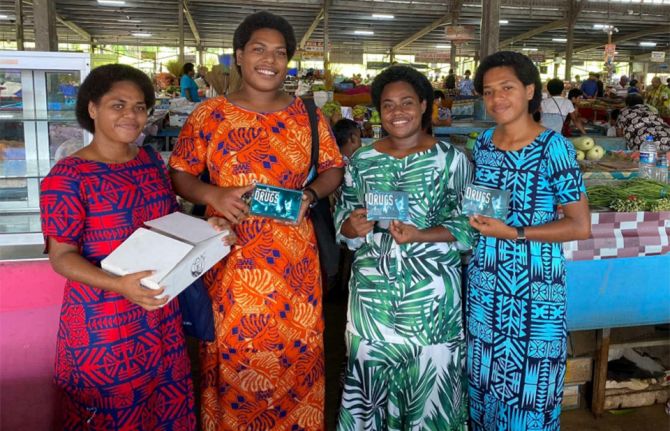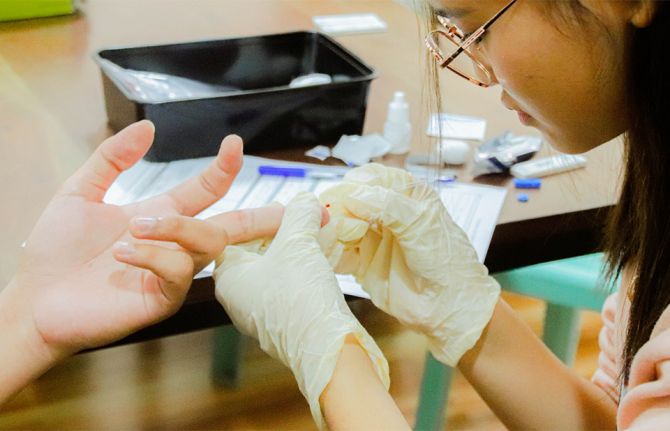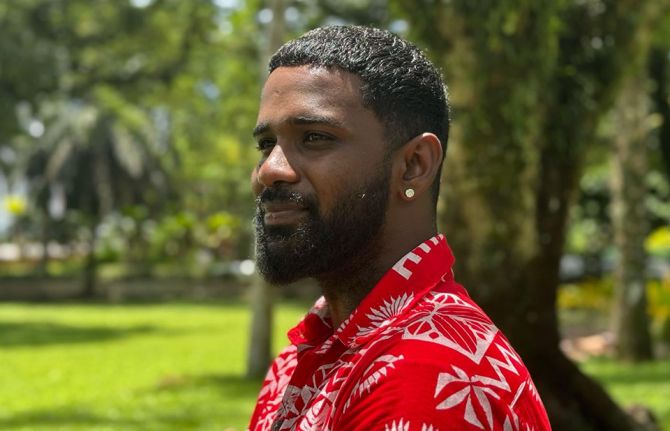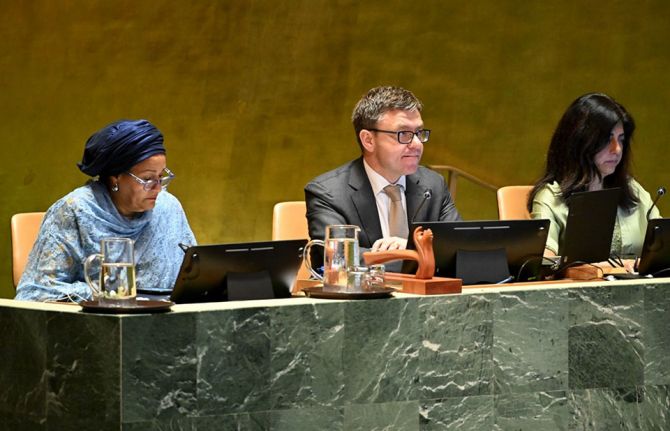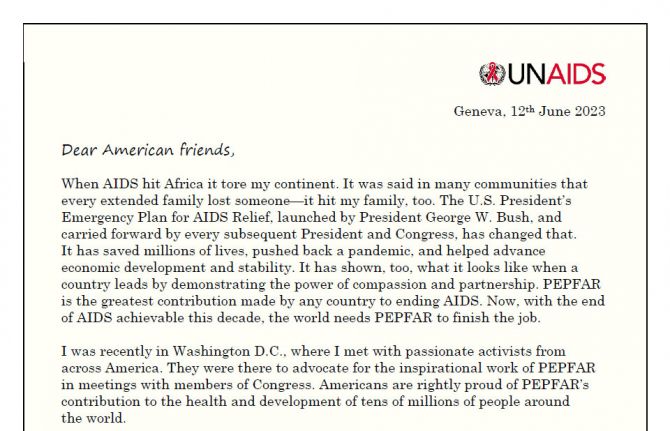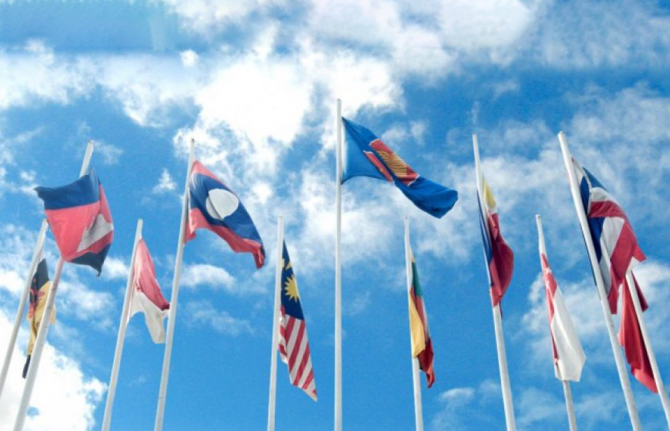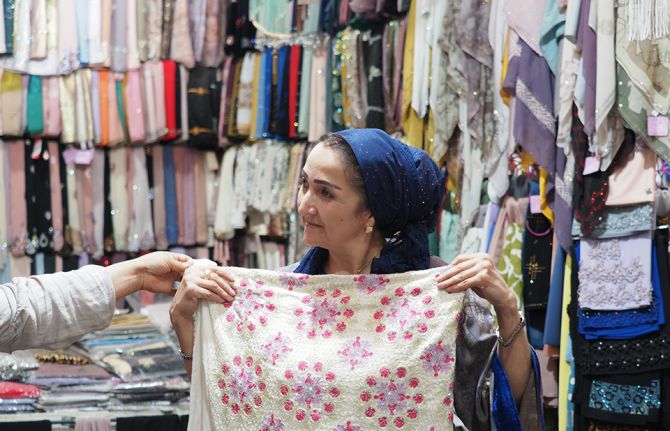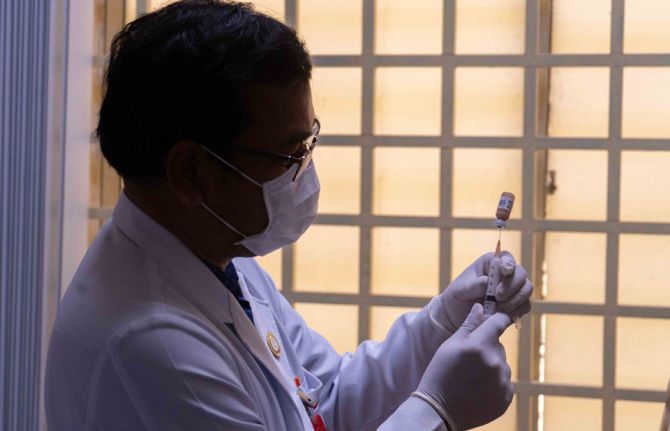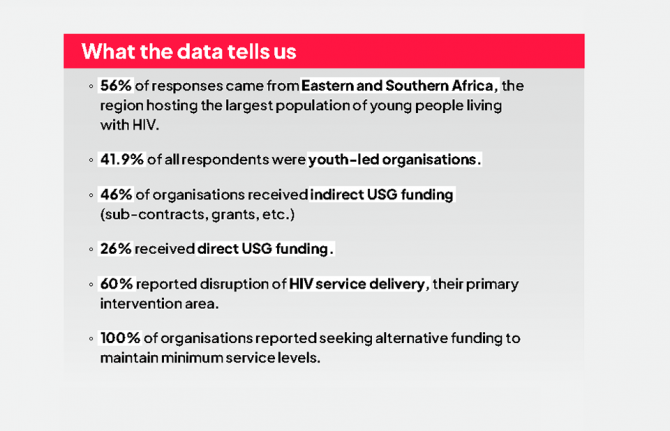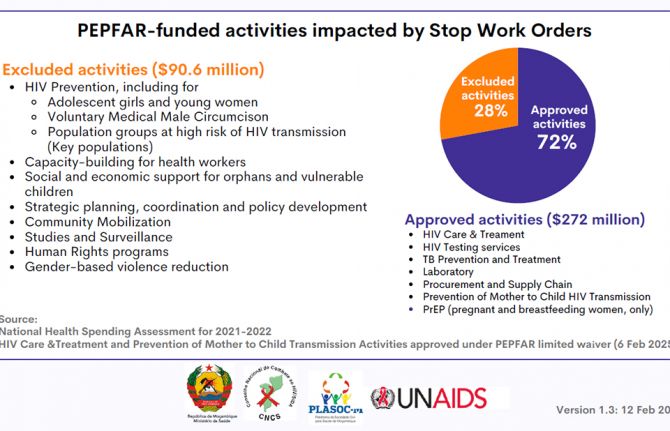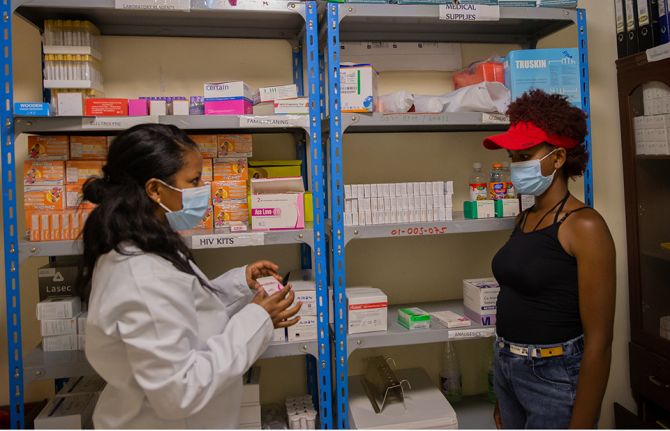
Feature Story
Launch of the 2007 Global Tuberculosis Control Report
23 March 2007
23 March 2007 23 March 2007Global Tuberculosis Control Report

UNAIDS Executive Director Dr Peter Piot with the Director General of the World Health Organisation Dr Margaret Chan at the launch of the Global Tuberculosis Control Report in Geneva.

WHO Director General Dr Margaret Chan welcomed the new findings in the report and emphasised that TB needed to be tackled as part of the larger challenge of increasing access to primary health care services.
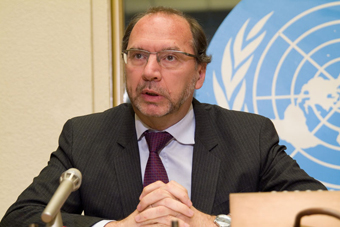
UNAIDS Executive Director Dr Peter Piot stressed the importance of scaling-up collaboration between the TB and HIV communities if the goal of universal access to quality TB and HIV prevention, diagnostic, treatment and care services is to be achieved.

Director of the WHO Stop TB Department Dr Mario Raviglione warned of the serious threat XDR-TB posed to the global response to AIDS and highlighted the need for greater funding to support research into new diagnostics, treatments and vaccines.

Dr Kevin de Cock, Director of WHO's HIV/AIDS programme welcomed the report's findings and underlined Dr Piot's message of strenghtening cohesion between groups working on TB and groups working on HIV..
All photo credit: D.Bregnard
Links:
Read more
Read TB Anywhere is TB Everywhere
Read UNAIDS interview with UN Special Envoy to Stop TB
Global Tuberculosis Control Report
Related
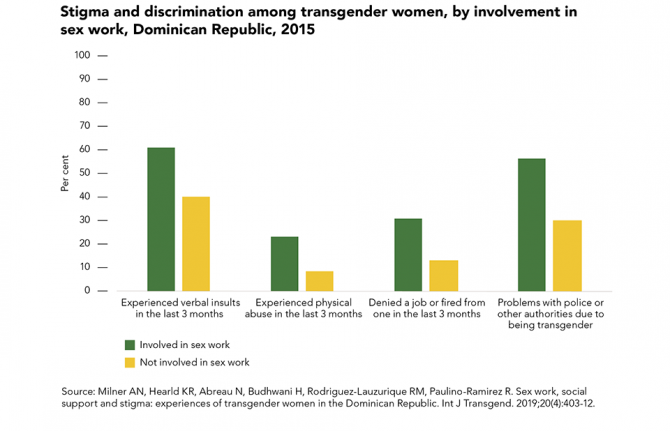 Transgender sex workers face frequent abuse
Transgender sex workers face frequent abuse

29 March 2022
 Many key populations avoid health services
Many key populations avoid health services

21 February 2022

Feature Story
Together against TB and HIV
23 March 2007
23 March 2007 23 March 2007
TB ANYWHERE IS TB EVERYWHERE is the theme of this year’s World TB Day. UNAIDS, WHO and the Stop TB Partnership have come together this World TB Day to highlight their commitment to working together in scaling-up TB and HIV programmes and call for increased action on the two diseases.

HIV/TB features in World TB Day events
Events linked to World TB Day in Ghana and Malawi highlight the importance of greater collaboration between the HIV and TB communities in order to reduce the burden of these leading causes of death.
Read the full story
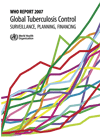
Global tuberculosis control
report
Launch of the 2007 Global Tuberculosis Control Report
At the launch of the WHO Global Tuberculosis Control Report, UNAIDS Executive Director highlighted the need for TB and HIV communities to scale up collaboration if the goal of universal access is to be achieved. The report, released by WHO, indicates that the worldwide TB epidemic has levelled off for the first time since it was declared a public health emergency in 1993. But despite these signs that the epidemic may be slowing, there are still major impediments to rapid progress against TB - prominent among them being the lack of investment, uneven access to diagnosis and treatment within countries, the emergence of XDR-TB, the inextricable links between HIV and TB and the ageing population.
Global Tuberculosis Control Report
Photo Gallery - Press launch of report
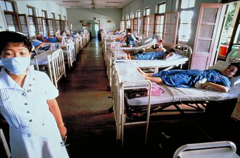
Photo credit:StopTB/T.Falise
TB ANYWHERE IS TB EVERYWHERE
Tuberculosis is both preventable and curable, so why today is TB still a global emergency? On World TB Day this year experts around the world will be debating this issue and looking into the reasons behind the chronic lack of investment in TB programmes and research.Also on the agenda this year will be the discovery of a strain of TB that is resistant to almost all drugs (extensively drug resistant TB – XDR TB); the deadly synergy between HIV and TB; and the ageing global population––all of which are jeopardizing the ability of TB control programmes around the world to cope.

Photo credit: WHO
Joining forces to tackle TB and HIV
TB is one of the biggest killers of people living with HIV and at least one third of the 39.5 million people estimated to be living with HIV around the world are likely to be infected with the TB bacteria. As a result of chronically poor investment in global TB control a new strain of TB is emerging that has become resistant to most of the available anti-tuberculosis drugs. Known as extensively drug resistant TB (XDR TB) this strain has serious implications for people living with HIV as it is almost untreatable in many of the countries where it is occurring leading to very high death rates. WHO and UNAIDS, together with other actors working on TB and HIV issues are stepping up action to stop the spread of TB and this deadly new strain.

Jorge Sampaio, UN Secretary General's
Special Envoy to Stop TB
UNAIDS interviews UN Special Envoy to Stop TB
UNAIDS asks the UN Secretary General’s Special Envoy to Stop TB and former President of Portugal, Dr Jorge Sampaio about his involvement in the fight against TB, its links with HIV and what he sees are the top priorities for HIV/TB collaboration in the future.
Together against TB and HIV
Links:
UNAIDS TB page
UN Special Envoy to Stop TB
Stop TB Partnership
World TB Day Events
The Global Plan to Stop TB
New WHO Data on TB
Stop TB eForum (HDN)
Videos:

Fight HIV, Fight TB, Fight Now
The Human Face of TB
Related stories:
TB Anywhere is TB Everywhere
Joining forces to tackle TB and HIV
Factsheets:
Frequently asked questions about Tuberculosis and HIV (33 Kb, pdf)
Frequently asked questions about XDR-TB (33 Kb, pdf)
Other Links:
What the papers aren't saying - How can we enhance media coverage of TB? (Panos Report)
Related

Feature Story
Focused AIDS programmes in Asia and the Pacific
21 March 2007
21 March 2007 21 March 2007It’s an unfortunate reality that all too often, the people most at risk and most in need of HIV prevention, treatment and care programmes are those least likely to have access to these services. According to latest estimates, only one in ten people ‘most at risk’ has access to prevention services. In many cases, for injecting drug users, sex workers and men who have sex with men, AIDS poses a double burden—on the one hand, there are a very limited number of programmes specifically designed to reach them, and on the other hand, they are often faced with discrimination, stigma and in some cases even criminal prosecution by the societies they live in.
But evidence and experience shows that focusing AIDS programmes and services specifically on people who are most at risk leads to encouraging progress within the response and can help reduce stigma and discrimination.
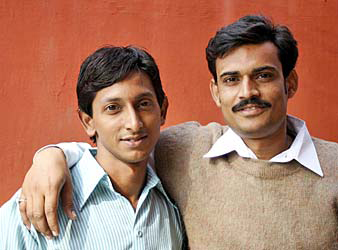
This month’s review of the UNAIDS Best Practice collection looks at the issue of men who have sex with men (MSM) in the Asia and the Pacific region and the focused programmes implemented in six countries that are showing progress.
In Asia, men who have sex with men are disproportionately affected by HIV. It is estimated that HIV prevalence is as high as 14% in Phnom Penh, Cambodia; 16% in Andrha Pradesh, India; and 28% in Bangkok, Thailand.
Men who have unprotected sex with men may also have unprotected sex with women and thus serve as an epidemiological bridge for the virus to the broader population. For example, a survey of over 800 men in China who have sex with men found that 59% reported having had unprotected vaginal sex with women in the previous year.
“It is a commonly held misperception that male-male sex happens only among men who self identify as ‘gay’. Most men who have sex with men living outside the West are not identifiable as such, they live and work in their communities unremarked and are often heads of families with children,” the Best Practice outlines
“HIV transmission prevention programmes addressing men who have sex with men are therefore vitally important. However, this population is often seriously neglected because of official denial by governments, the relative invisibility of men who have sex with men, stigmatization of male-to-male sex, ignorance or lack of adequate information,” it says.
The MSM programmes, implemented in Bangladesh, India, Indonesia, the Philippines, China and New Zealand, were chosen to be part of the UNAIDS Best Practice collection due to their success in providing comprehensive interventions that engage all actors involved in the AIDS response.
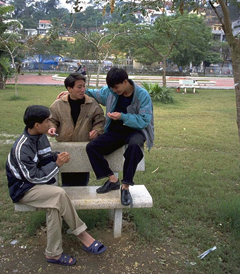
Although different in their make-up, the programmes have common elements and activities that have proved to be effective in reaching and supporting men who have sex with men on AIDS issues in Asia.
Advocacy activities with governments, health services and mainstream communities are common to all programmes. In Bangladesh, successful advocacy from the Banhu Social Welfare Society, including networking and participation in governmental meetings, has ensured the inclusion of issues relating to men who have sex with men in the five-year National AIDS Strategic Plan. In Indonesia, the Aksi Stop AIDS and Family Health International programme have worked hard to engage the authorities in the AIDS response. The Indonesian Ministry of Health is now recognising the seriousness of the situation and communities of men who have sex with men have been invited to participate in consultations on AIDS-related issues.
The Best Practice publication highlights a number of interesting outreach activities that some of the programmes are implementing. For example, in Hong Kong, the ‘AIDS concern’ organization set up a programme focusing on customers of saunas. Materials promoting safer sex such as leaflets, comic books and information brochures were produced and distributed across 13 saunas and outreach workers met with owners and staff to foster relationships and assess the situation. Increasingly, condoms, and lubricant were also distributed. “Good relations between the outreach workers and the sauna owners continue and there have been increased opportunities for contact with clients as a result of testing services. As a result clients are less apprehensive,” the publication states.
The programmes highlighted in the publication underline that activities implemented by people living with HIV have been proven to be more effective and help to further break down AIDS-related stigma and discrimination.
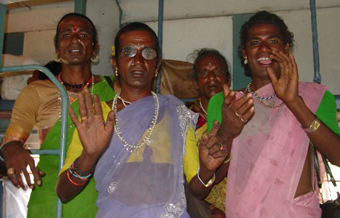
Know your epidemic
As the Best Practice outlines, in many countries, prevention efforts are hindered by laws that criminalize male-male sex, making work with men who have sex with men difficult and hindering their contribution to the response to the epidemic. Where social, cultural and religious attitudes make the issue politically sensitive, politicians are generally reluctant to support policies and programmes that might result in public criticism from community leaders and groups .
HIV prevention programmes for men who have sex with men like those featured in the Best Practice are vitally important to stop HIV transmission. However, lack of research about men who have sex with men including their behaviours and attitudes, and criminalization and stigmatization of and legal discrimination against these men, are also significant barriers to implementing effective programmes. Research was an integral part to the success of the AIDS Concern sauna outreach activities in Hong Kong – as part of the activity a research project was undertaken to determine the prevalence of high risk behaviours among sauna clients, levels of access to free condoms and lubricant, and the nature of information materials that would be best suited to sauna clients.
Through the examples of the six MSM programmes, the publication underlines that HIV programming for men who have sex with men needs to be carefully tailored to local cultures and conditions. Rather than relying on approaches based on patterns of male-male sexual behaviour observed in Western Europe and North America, local sexual minorities should be identified and engaged in developing programmes. In New Zealand, the New Zealand AIDS Foundation promotes the use of a community’s cultural resources to make AIDS information materials relevant and attractive. Designs, images, colours, language and models are used which are instantly recognizable as belonging to either the Maori or Pacific Islander communities.
As the Best Practice underlines, UNAIDS supports a range of responses aimed at reducing the vulnerability of men who have sex with men to HIV and its impacts including the promotion of high-quality condoms and water-based lubricants, ensuring their continuing availability; safer-sex campaigns and skills training; peer education among men who have sex with men and female partners; and strengthening organizations of self-identified gay men, enabling them to promote and rapidly increase HIV prevention and care programmes for men who have sex with men.
“Twenty five years into this epidemic, the reality is that only one in ten men who have sex with men have access to HIV prevention services. This is a massive failure, and setting it right has to be among the highest priorities for the increasingly strong global AIDS response as we aim to achieve universal access to HIV prevention, treatment, care and support for all groups, including men who have sex with men and transgender people,” said Purnima Mane, UNAIDS Director of Policy, Evidence and Partnerships.
Links:
Download the Best Practice: HIV and Man who have Sex with Men in Asia and the Pacific
Read more on men who have sex with men (MSM)
Download UNAIDS Policy brief on MSM ( en | fr | es | ru | pt ) (227 Kb, pdf)
Other UNAIDS Best Practice reviews:
Learning from experience
A faith-based response to HIV in Southern Africa
Traditional Healers join the AIDS response

Feature Story
UNAIDS interviews UN Special Envoy to Stop TB
21 March 2007
21 March 2007 21 March 2007
Jorge Sampaio, UN Secretary General's
Special Envoy to Stop TB
Ahead of World TB Day, UNAIDS asks the UN Secretary General’s Special Envoy to Stop TB and former President of Portugal, Dr Jorge Sampaio about his involvement in the fight against TB, its links with HIV and what he sees are the top priorities for HIV/TB collaboration in the future.
1. During the last decade, you have made important contributions to many of the challenges currently facing the international community. What made you passionate about becoming more involved in TB?
For me, health for all is a matter of human rights. Three out of the eight Millennium Development Goals are health-related and include fighting against the three global pandemics, AIDS, tuberculosis and malaria. I’ve been aware of TB all my life because my father was a doctor––but I realized that TB was a major new public health emergency when the MDGs started being discussed around the turn of this century.
2. How do you think your role in politics is helping you to fulfil your new role as Special Envoy to Stop TB?
I am a lawyer by profession and obviously that helps with advocacy, I have also had a long political career (now I am retired!), so I am used to political negotiations and have had a lot of experience in diplomatic and international affairs. In my personal view, political experience is critical because my role as a Special Envoy is not to settle technical questions, but rather to increase political and social support for the TB control policies recommended by WHO and the Stop TB Partnership. My main focus is to persuade world leaders, policy makers, main international, regional and national stakeholders, the media, the private sector, patients, communities and others to secure greater political support for fully funding and implementing the Global Plan to Stop TB.
3. What role do you think the HIV community and UNAIDS can play in implementing the Global Plan to Stop TB?
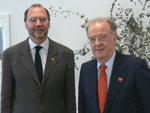
Jorge Sampaio Met with UNAIDS
Executive Director, Dr Peter Piot
in Geneva earlier this year to
move the agenda forward on TB
control including the HIV/TB co-
epidemic and XDR-TB
One of the main points I always emphasize is the need to stimulate a co ordinated approach to HIV and TB. Together HIV and TB generate a noxious synergy that accelerates each other’s progression and has led to an explosion of TB cases in regions with high HIV prevalence. In order to control TB in high HIV prevalence settings far more effective collaboration between TB and HIV programmes and communities must be implemented.
I do think that the Global Plan to Stop TB and TB programs based on the WHO Stop TB strategy, as well as UNAIDS’ plans for universal access to HIV prevention, treatment, care and support represent an appropriate framework to scale up TB/HIV collaborative efforts. But some gaps remain––particularly in the areas of political and resource commitment to collaborative TB/HIV activities and new tools for prevention, early diagnosis and rapid treatment of TB in people living with HIV.
4. How can we encourage the TB and HIV communities to work more closely together?
Education for health is dramatically needed to counteract stigma and social discrimination surrounding HIV and TB. Communities have to know the basic facts; TB causes at least 11% of total deaths in people living with HIV (this can rise to as much as 60% in some African settings); 750,000 people living with HIV develop TB each year; most TB can be successfully treated even in people living with HIV; untreated, TB will cause death within weeks for people living with HIV; t reatment of TB can prolong and improve the quality of life for HIV-positive people.
5. How do you think we can keep the world interested in TB and HIV, despite competing issues such as global warming, avian flu, terrorism?
Health is a key dimension of human safety and development, and is a matter of human rights. To realize these very basic rights worldwide, we need to double efforts and avoid working at cross-purposes which delays us unnecessarily.
6. If we are to have a real chance of getting ahead of these epidemics what, in your opinion, are the areas that the world should be focusing on?

UN Secretary-General Ban Ki-moon with
Jorge Sampaio at UN Headquarters in
New York
In my own personal view, four overarching but long overdue issues deserve immediate attention and call for strong extra action by the international community.
First, keeping the fight against TB high on the global agenda, particularly in light of the emerging of multidrug-resistant and extensively drug-resistant TB, which poses a new major public health threat and requires urgent action.
Secondly, improving coordination in the fight against AIDS and TB.
Third, Africa . Africa must be top priority and put at the highest spot on the international agenda––it is not acceptable that it should remain a continent at risk. Sub-Saharan Africa faces the greatest health challenges, with 11% of the world’s population and 24% of the global burden of TB disease, yet only 3% of the world’s health workers.
Fourth, s trengthening health systems––promoting a global plan to strengthen health systems is a key issue in achieving most of the health related MDGs.
All photo credit: Stop TB Partnership
UNAIDS interviews UN Special Envoy to Stop TB
Links:
UNAIDS TB page
UN Special Envoy to Stop TB
Stop TB Partnership
World TB Day Events
The Global Plan to Stop TB
New WHO Data on TB
Stop TB eForum (HDN)
Videos:

Fight HIV, Fight TB, Fight Now
The Human Face of TB
Related stories:
TB Anywhere is TB Everywhere
Joining forces to tackle TB and HIV
Factsheets:
Frequently asked questions about Tuberculosis and HIV (33 Kb, pdf)
Frequently asked questions about XDR-TB (33 Kb, pdf)
Other Links:
What the papers aren't saying - How can we enhance media coverage of TB? (Panos Report)
Related

Feature Story
TB Anywhere is TB Everywhere
20 March 2007
20 March 2007 20 March 2007
Photo credit:StopTB/T.Falise
Tuberculosis (TB) remains a global emergency despite the fact that it is a preventable and curable disease. Chronic lack of investment in TB programmes and research into new ways to diagnose, treat and prevent TB have left us extremely vulnerable to the new, emerging threats to TB control. The discovery of TB that is resistant to almost all drugs (extensively drug resistant TB – XDR TB); the deadly synergy between HIV and TB; and the ageing global population jeopardize the ability of TB control programmes around the world to cope.
World TB Day on 24 th March aims to focus the world’s attention on these and other major challenges that face global TB control. Achieving the TB-focused targets of the United Nations' Millennium Development Goals by 2015 will depend on increased global commitment to TB control, and greater investment in research and the health services that deliver TB services.

Photo credit:StopTB/P.Virot
TB is one of the biggest killers of people living with HIV. At least one third of the 40 million people estimated to be living with HIV around the world are likely to be infected with the TB bacteria and at greatly increased risk of developing TB disease. Up to 80% of TB patients are co-infected with HIV in sub-Saharan Africa. Improved collaboration between TB and HIV programmes will lead to more effective control of TB among people living with HIV and can ensure that HIV positive TB patients get the HIV treatment and care they need.
"The TB and HIV communities can do much more together to address these leading causes of illness and death than they can apart. Much greater collaboration is essential if we are going to reach our common goals of achieving universal access to TB and HIV prevention, diagnostic and treatment services," said Dr Alasdair Reid, HIV/TB Adviser, UNAIDS.
The Global Plan to Stop TB lays out a budgeted plan for what the world needs to do to achieve the TB-focused Millennium Development Goals, including collaborative TB/HIV activities. If fully funded and implemented it will lead to 50 million cases of TB being treated and 14 million lives saved by 2015. However, in its first year the Global Plan is already under-funded.
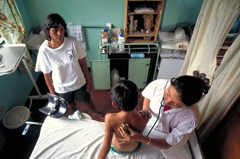
Photo credit:StopTB/J.Davenport
The plan emphasizes the need for governments of high TB burden countries and donors to increase investment in TB control; greater involvement of affected communities in the response to TB; the need to protect communities from the threat of drug-resistant TB and HIV-related TB; and the need for funding for research into new and effective TB drugs, diagnostics and vaccines.
Ahead of World TB Day, the World Health Organization will release ‘Global TB Control Report’ which outlines the progress on achieving the 2005 global TB control targets. The report will be available on March 22nd at www.who.int/tb.
TB Anywhere is TB Everywhere
Links:
UNAIDS TB page
UN Special Envoy to Stop TB
Stop TB Partnership
World TB Day Events
The Global Plan to Stop TB
New WHO Data on TB
Stop TB eForum (HDN)
Videos:

Fight HIV, Fight TB, Fight Now
The Human Face of TB
Related stories:
Joining forces to tackle TB and HIV
Factsheets:
Frequently asked questions about Tuberculosis and HIV (33 Kb, pdf)
Frequently asked questions about XDR-TB (33 Kb, pdf)
Other Links:
What the papers aren't saying - How can we enhance media coverage of TB? (Panos Report)
Related

Feature Story
“Leadership”: theme for World AIDS Day 2007-2008
16 March 2007
16 March 2007 16 March 2007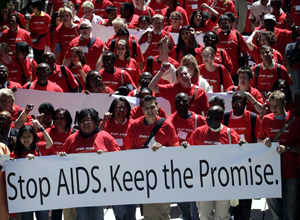
"Leadership" has been chosen by the World AIDS Campaign as the theme for World AIDS Day 2007 and 2008. This theme will continue to be promoted with the slogan "Stop AIDS. Keep the Promise."—the World AIDS Campaign (WAC) emphasis from 2005-2010.
On December 1 every year, the world comes together to commemorate World AIDS Day. The theme for World AIDS Day has been determined by the World AIDS Campaign since 1997.
“We know that significant advances in the response to HIV have been achieved when there is strong and committed leadership. Leaders are distinguished by their action, innovation and vision; their personal example and engagement of others; and their perseverance in the face of obstacles and challenges,” said the World AIDS Campaign. “Leadership must be demonstrated at every level to get ahead of the epidemic- in families, in communities, in countries and internationally.”
“Much of the best leadership on AIDS has been demonstrated within civil society organisations challenging the status quo. Making leadership the theme of the next two World AIDS Days will help encourage leadership on AIDS within all levels and sectors of society,” the Campaign added.
The 2007/8 theme of “Leadership” will build on the 2006 World AIDS Day focus on accountability, and was selected by the Global Steering Committee of the World AIDS Campaign during their meeting held in Geneva in February.
“We are still dying! Leadership requires that we face this reality. While scaling up of HIV care is now prioritized, it is under funded and poorly implemented,” said WAC Steering Committee Member and Chairperson, Global Network of People Living with HIV/AIDS Deloris Dockrey.

“Leadership can imply the power and authority to make a difference, to lead by action and example,” added fellow Steering Committee member and Coordinator for the Ecumenical Advocacy Alliance, Linda Hartke. “By taking on the global theme of leadership for World AIDS Day, faith leaders and the communities they are a part of can help articulate a vision, build relationships and take concrete action in solidarity with all people committed to reaching universal access for HIV prevention, treatment and care.”
The overall purpose of the World AIDS Campaign from 2005 to 2010 is to ensure that leaders and decision makers deliver on their promises on AIDS, including the provision of Universal Access to Treatment, Care, Support and Prevention services by 2010. Within that five-year mission, annual campaigning themes are selected which are timely, relevant and adaptable to a number of different regions and issues.
The issue of continued and increased leadership on AIDS and it’s importance to a long-term sustainable AIDS response was underlined by UNAIDS Executive Director Peter Piot at the European AIDS Conference held in Bremen, Germany on 12-13 March. “ Leadership makes or breaks the response against AIDS,” he said.
The Global Steering Committee of World AIDS Campaign is comprised of the Global Network of People Living with HIV/AIDS, the International Community of Women Living with HIV/AIDS, the Youth Coalition, the Global Unions Programme on HIV/AIDS, the International Council of AIDS Service Organisations, the Ecumenical Advocacy Alliance, and the International Women’s AIDS Caucus. UNAIDS and the Global Fund to Fight AIDS, TB and Malaria are non-voting members.
Links:
More information about the 2007/8 World AIDS Day theme
World AIDS Campaign Website
Related

Feature Story
One woman’s fight against AIDS in Ukraine
13 March 2007
13 March 2007 13 March 2007
Tatiana Semikop’s story begins in 1994 when she was working as a criminal police officer in Odesa. That was the year Tatiana met an 11-year-old boy living with HIV who did not know who or where to turn to for help and support. At the time Tatiana knew very little about AIDS but wanted to help the boy, so she set out to learn more and to find out how he could get support. However, the more Tatiana looked, the more she realized there was little available.
“I was shocked,” said Tatiana. “I couldn’t believe that no-one in the oblast or even the city could give me the information I was looking for, no-one seemed to know anything, it was as if the disease didn’t exist,” she added.
Finding out more
During her efforts to find out more about AIDS, Tatiana heard about a workshop being organized by UNAIDS to provide on HIV prevention for law enforcement groups. Through this workshop she gained vital knowledge on the complex issues related to AIDS in Ukraine and the different kinds of interventions needed in the country to help stem the spread of the disease.
Ukraine is facing the most severe AIDS epidemic in Europe. At the end of 2005, nearly 400,000 people were living with HIV in Ukraine and adult HIV prevalence was estimated at over 1.4%. Ukraine’s epidemic is primarily concentrated among people considered to be most ‘at-risk’—and 60% of the people living with HIV inject drugs.
“Using non-sterile injecting equipment is the major driver of the AIDS epidemic in Ukraine,” said Anna Shakarishvili, UNAIDS Country Coordinator in Ukraine. “More than 45% of new HIV infections reported in the first half of 2006 were in people who inject drugs. But sexual transmission of the infection from drug users is also rapidly increasing and the number of children born to HIV positive mothers continues to rise,” she added.

Unprecedented approach
Through her police work, Tatiana encountered injecting drug users on a regular basis and to her it made sense to start focusing her HIV prevention work here. With her help, Ukraine’s first projects to reduce harm from injecting drug use were initiated and implemented.
A unique feature of the programmes was the cooperation with the law enforcement groups and an agreement by Odesa’s Mayor to say these activities could take place—a groundbreaking move for the country at that time.
“We couldn’t believe that we had really dared to take such an unprecedented and unique approach to tackling the epidemic,” said one of the seven members of the small team who started the pilot project. “This had never been done before in Ukraine,” she added.
From these modest beginnings, today there are programmes focusing on injecting drug users and HIV across Ukraine which have become commonly recognized and respected HIV prevention tools.
Twelve years later
Twelve years since first encountering the issue of AIDS, Tatiana Semikop has moved up to the ranks of police lieutenant-colonel, is an author of a scientific dissertation on the psychological characteristics of police work relating to AIDS, and is the Chairwoman of one of the most efficient non-governmental HIV-service organizations in Ukraine – Vera, Nadezhda, Lubov (“Faith, Hope and Love”). In March this year Tatiana Semikop received her second ‘Woman of the Year’ award from law enforcement groups in Odesa for her continued commitment and dedication to the AIDS response.
Inspired by their mother’s example, Tatiana’s children have followed in her footsteps. Her 16-year old daughter Nina, gives lectures on AIDS at her secondary school, participates in various projects and writes articles on AIDS for a city newspaper. Her 24 year-old son Evgeny has already become a coordinator of one of the HIV-service projects in Odesa.
Vera, Nadezhda, Lubov
Tatiana’s organization Vera, Nadezhda, Lubov provides a variety of services across Odesa and neighbouring districts –-including a special mobile voluntary counselling and testing outlet that tests female sex workers for HIV and sexually transmitted infections at the site of their work; and helps women who have suffered domestic violence.

The organization has more than 100 members and provides information services and training on AIDS and other related issues at educational institutions around the city and in the rural areas. Vera, Nadezhda, Lubov also publishes a newspaper for people who inject drugs, sex workers and people living with HIV.
Tatiana is particularly proud of the creation of a community centre for people living with HIV and people most at risk of HIV infection. “We organise nature trips, holidays and we have special visiting photo exhibitions, a self help group and a social club,” she said.
Working on AIDS issues has become a source of inspiration for Tatiana and her colleagues. Many of the organization’s employees have personal experiences of drug addiction and came to know about the organization when seeking support. Now, having received training and professional experience, they have become indispensable employees, committed to helping others going through similar life situations.
“The explanation for our success is very simple,” said Tatiana. “We believe in what we are doing, and we see the fruit of our efforts every day.”
Links:
Read more on Ukraine
Read more on the European AIDS Conference: Responsibility and Partnership – Together against HIV/AIDS

Feature Story
Cricket World Cup raises AIDS awareness
11 March 2007
11 March 2007 11 March 2007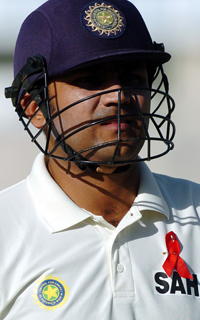
Photo credit:UNAIDS/ICC
Amidst celebrations at the opening of the ICC Cricket World Cup in the Caribbean on Sunday 11 March, players and spectators around the world were asked to reflect on the lives of children and young people living with and affected by HIV in the region.
The message came as part of joint efforts between the International Cricket Council (ICC), UNAIDS, UNICEF and the Caribbean Broadcast Media Partnership on HIV/AIDS (CMBP) to draw attention to the issues facing children and young people affected by HIV and to highlight the need to step-up action on AIDS in the region.
The Cricket World Cup is the highlight of the cricketing year. More than two billion television viewers are expected to tune in over the next seven weeks to watch 16 teams battle it out for a place in the World Cup final, to be held in Barbados on 28 April.
AIDS-awareness activities
Through a number of activities to be held over the next seven weeks, the public, especially young people aged 15-24, will get information on stigma and discrimination around HIV and on how to protect themselves against the virus. The partnership is part of the ICC’s commitment to promoting the ‘Spirit of Cricket’ and its positive impact on society and its commitment to support the Unite for Children, Unite against AIDS campaign launched in 2005 by UNICEF, UNAIDS and other partners.
“The spirit of cricket is a special part of our game and is a concept that stretches beyond the boundaries of the outfield,” said ICC President Percy Sonn. “We hope the range of activities delivered at the ICC Cricket World Cup 2007 will make a difference to raising awareness and reducing stigma around HIV in the Caribbean and across the ever-growing cricket world,” he added.
A series of video messages supporting the Unite for Children. Unite against AIDS campaign by 28 of the world’s top cricketers, including Australian captain Ricky Ponting and Indian captain Rahul Dravid, will be broadcast on TV and at the matches.

Photo credit:UNAIDS/ICC
Players and officials from each team will wear the red and blue campaign ribbon during their first games and during the final. Players will also visit programmes in the Caribbean supporting children and young people affected by HIV.
As part of the events around the World Cup, the Caribbean Broadcast Media Partnership on HIV/AIDS – a coalition of over 50 broadcasters in 23 Caribbean countries and territories – is also launching the region’s first media-led, multi-platform campaign on HIV/AIDS, known as LIVE UP! The campaign aims to inspire the people of the Caribbean, especially young people, to consider what they can do to stem the spread of HIV.
"The exceptional reach of broadcast media in the Caribbean gives us a unique opportunity to educate audiences about how to avoid HIV, and how to combat the stigma and discrimination that surround the disease," noted CBMP Steering Committee Chair Allyson Leacock. "By doing what we do best, communicating with our neighbours, members of the CBMP are helping our audience to remain healthy and well-informed, while we all work together to reduce the impact of HIV in our region."
Sport – a force for change
Cricket is popular in many of the countries that are most impacted by AIDS, including India and South Africa. Together, these two countries are home to around 11 million of the 40 million people living with HIV worldwide.
In the Caribbean, UNAIDS estimated that 250,000 people – 15,000 of whom were children under the age of 15 – were living with HIV in 2006.
“Young people today have never known a world without AIDS. Sports stars – such as top cricket players – can act as role models for today’s young generation and reach out to them on AIDS issues,” said UNAIDS Executive Director Dr. Peter Piot. “Sport is a force for change that can break down barriers, build self-esteem and teach life skills and social behaviour. By highlighting AIDS issues, the ICC Cricket World Cup and its cricketing stars are showing exactly the kind of exceptional response needed for the exceptional challenge of AIDS.”
For more information on the AIDS activities around the Cricket World Cup and to access the public service announcements please visit the following links:
Special page on Cricket World Cup
International Cricket Council
Live Up Campaign
Caribbean Broadcast Media Partnership on HIV/AIDS
Related

Feature Story
European AIDS Conference 2007
11 March 2007
11 March 2007 11 March 2007Representatives of 27 European Union and neighbouring countries met in Bremen, Germany to discuss ways of strengthening political leadership in the response to AIDS. Over 600 people attended the conference which was organised by the German Federal Government as part of its 2007 European Union Presidency. UNAIDS Executive Director Dr Peter Piot spoke on the opening day about the epidemic in the region and actions necessary to curb the epidemic. The second day of the Conference included workshops covering many key aspects of the AIDS response in the region including presentations on human rights, migration, stigma, gender and issues concerning sex work, injecting drug use and men who have sex with men.
 | UNAIDS Executive Director, Dr.Peter Piot talks to Ms. Angela Merkel, Chancellor of the Federal Republic of Germany at the 2007 European AIDS Conference in Bremen, Germany, 12-13 March 2007. |
 | Ms. Angela Merkel, Chancellor of the Federal Republic of Germany during her speech at the 2007 European AIDS Conference in Bremen, Germany, 12-13 March 2007. |
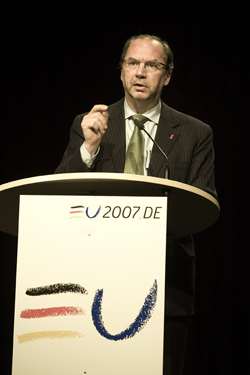 | UNAIDS Executive Director, Dr. Peter Piot during his speech at the 2007 European AIDS Conference in Bremen, Germany, 12-13 March 2007 |
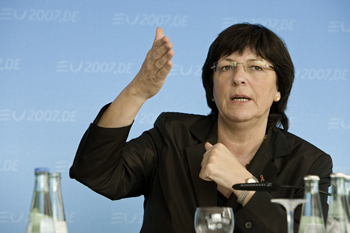 | Ms. Ulla Schmitt, Germany's Federal Minister of Health at the closing press conference of the European AIDS Conference in Bremen, Germany. 12-13 March 2007 |
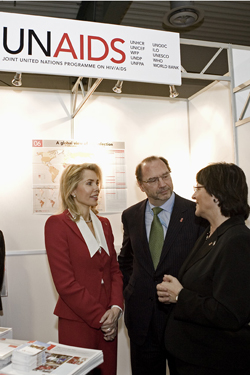 | UNAIDS Executive Director, Dr. Peter Piot visiting the UNAIDS stand with Her Highness Begum Aga Khan and Germany's Federal Minister of Health, Ms. Ulla Schmitt at the 2007 European AIDS Conference in Bremen, Germany. 12-13 March 2007. |
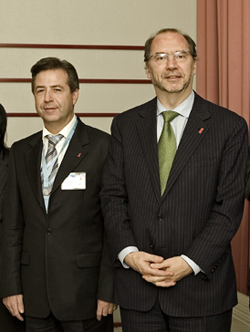 | UNAIDS Executive Director, Dr. Peter Piot met with the Ukranian Minister of Health, Mr. Yuyi Poliachenko at the 2007 European AIDS Conference in Bremen, Germany. 12-13 March 2007 |
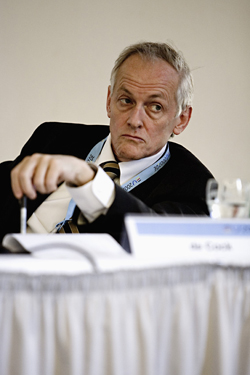 | Mr. Kevin De Cock, Director of the department of HIV/AIDS at the World Health Organisation at a workshop on the role of the European Union and the European States in the world-wide fight against AIDS, during the 2007 European AIDS Conference. 12-13 March 2007 |
 | Ms. Sophia Kistling, Director of the International Labour Organisation's programme on AIDS at a workshop on the role of the European Union and the European States in the world-wide fight against AIDS, during the 2007 European AIDS Conference. 12-13 March 2007 |
 | Ms. Nina Ferencic, UNICEF's Regional Advisor for AIDS in Central and Eastern Europe at a workshop on cross-border cooperation in Europe during the 2007 European AIDS Conference in Bremen, Germany. 12-13 March 2007 |
 | Ms. Dorothee Eckertz, World Bank Operations officer, speaking on lessons learned in harm reduction in the wider european neighbourhood at a workshop on human rights during the 2007 European AIDS Conference. |
All photo credit: N.Wolff
Links:
Read more
Read UNAIDS Executive Director's speech (pdf, 41 Kb)
Read German Federal Chancellor's speech (de)
Related

Feature Story
Responsibility and Partnership – Together against HIV/AIDS
11 March 2007
11 March 2007 11 March 2007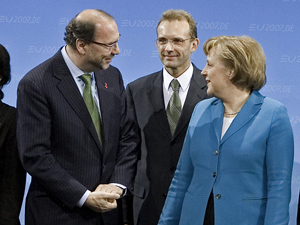
UNAIDS Executive Director Dr. Peter Piot with Ms. Angela Merkel,
Chancellor of the Federal Republic of Germany
The northern city of Bremen is the setting chosen by the German Federal Government to host the conference of the German Presidency of the Council of the European Union: “Responsibility and Partnership – Together Against HIV/AIDS”.
Germany has convened the conference as part of efforts to fulfil its pledge of making AIDS its top health priority during Germany’s European Union Presidency in 2007. The German Government has recently reaffirmed this commitment by announcing 400 Million Euros in 2007 for its action plan on AIDS.
The conference, taking place from 12-13 March, is expected to attract over 600 people from around Europe including ministers and representatives from 27 European and neighbouring countries. German Federal Chancellor, Dr Angela Merkel will give the keynote address and UNAIDS Executive Director Dr Peter Piot will speak on the opening day about the epidemic in the region and actions necessary to curb the epidemic.
The conference comes as a follow-up to the 2004 meetings in Dublin and Vilnius where groundbreaking declarations to step up political action on AIDS were signed by participating European ministers.
The second day of the Conference will comprise of workshops covering many key aspects of the AIDS response in the region including presentations on human rights, migration, stigma, gender and issues concerning sex work, injecting drug use and men who have sex with men.

UNAIDS Executive Director Dr. Peter Piot with Germany's
Federal Minister of Health, Ms. Ulla Schmitt
At the close of the conference the attending ministers of health are expected to sign a declaration reaffirming the commitments made in Dublin and Vilnius in a bid to increasing political leadership on AIDS on national, regional and international levels.
UNAIDS is currently coordinating a review of the 2004 meetings which the German Ministry of health is supporting financially, having recently announced 400,000 Euros for initiation of the project.
“ Germany is a valued partner of UNAIDS,” said Bertil Lindblad, UNAIDS Regional Director for Europe. “This is an important year for Germany as holders of both the EU and G8 Presidencies and its commitment to making AIDS its top health priority is not only a commendable decision but a truly necessary one.”
Links:
Read UNAIDS Executive Director's speech
Read German Federal Chancellor's speech (de)
View photo gallery
Visit official website
Visit Germany 2007 - Presidency of the European Union website
Read International Labour Organisation's feature - HIV/AIDS and the European workplace: Bringing the fight against AIDS to the shopfloor
Read Germany's Federal Government story

